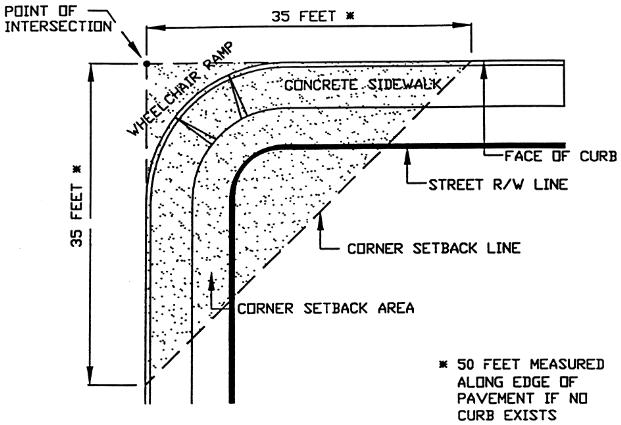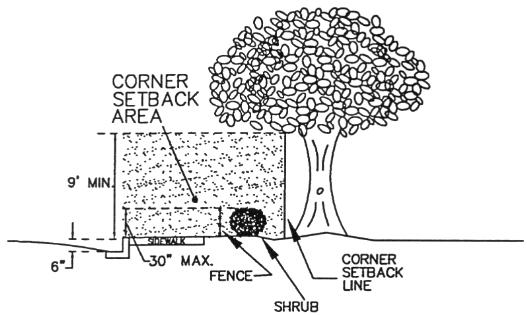Chapter 4.20
CORNER SETBACK AREAS – RIGHT-OF-WAY OBSTRUCTIONS
Sections:
4.20.010 Corner setback area defined.
4.20.020 Prohibition of obstructions in corner setback area.
4.20.030 Public right-of-way traffic area defined.
4.20.040 Prohibition of obstructions in public right-of-way traffic areas.
4.20.050 Prohibited obstructions – Enforcement.
4.20.060 Prohibited obstructions – Public nuisance.
4.20.010 Corner setback area defined.
At the intersection of any street improved for public traffic, there shall be a corner setback area. This area shall be the area within the thirty-five-foot triangle of public or private property measured from the intersection of the projected curb lines or the area within the fifty-foot triangle of public or private property measured from the intersection of the projected edges of pavement where there are no curbs (see Figure 1). A corner setback area shall not be established at intersections where traffic signals or all-way stop controls have been installed. (Ord. 613, § 10; 1976 Code § 4-4.01).
FIGURE 1.
CORNER SETBACK AREA
4.20.020 Prohibition of obstructions in corner setback area.
The corner setback area shall be maintained free of sight distance obstructions to promote safe movement of vehicle, bicycle and pedestrian traffic through an intersection as vehicle, bicycle and pedestrian are defined in Sections 670, 231 and 467, respectively, of the California Vehicle Code. It shall be a violation of this chapter for any property owner or other responsible party to maintain trees, shrubs or other landscaping elements or to erect, or cause to be erected, any obstruction such as a fence, awning, sign, or other structure that is at a height greater than thirty inches above the top of the adjacent curb grade, or at a height greater than thirty-six inches above the nearest pavement surface where there are no curbs.
For the purposes of this section, a tree trunk having no limbs lower than nine feet above adjacent top of curb grade, or lower than nine and one-half feet above the nearest pavement grade where there are no curbs, shall not be deemed an obstruction provided the number and/or location of tree trunks themselves do not create an obstruction.
For areas to be maintained free of sight distance obstructions as defined herein, see Figure 2. (Ord. 613, § 10; 1976 Code § 4-4.02).
FIGURE 2.
SIGHT DISTANCE CLEARANCES
4.20.030 Public right-of-way traffic area defined.
Within any public right-of-way, the area improved for the movement and parking of vehicles and bicycles and for the movement of pedestrians is designated as a public right-of-way traffic area. (Ord. 613, § 10; 1976 Code § 4-4.03).
4.20.040 Prohibition of obstructions in public right-of-way traffic areas.
The public right-of-way traffic area shall be maintained free of sight and mobility obstructions to promote safe movement of vehicle, bicycle and pedestrian traffic. The public right-of-way traffic area shall also be maintained free of obstructions which adversely affect improvements installed to facilitate the movement of vehicles, bicycles and pedestrians or adversely affect public utility mains, service laterals and other appurtenances. It shall be a violation of this chapter for any property owner or other responsible party to erect or maintain any of the following within the public right-of-way traffic area:
A. Tree branches, shrubs or other landscaping elements or obstructions such as a fence, awning, sign, or other structure which is lower than nine feet above adjacent top of curb grade, or lower than nine and one-half feet above the nearest pavement surface where there are no curbs.
B. Any branches, plants, hedges or foliage which interfere with visibility on, or mobility over, or access to, any portion of a public right-of-way traffic area.
C. Vines or climbing plants growing into or over any street tree, public hydrant, utility pole, traffic or street sign, traffic signal, or electrolier.
D. Any tree or shrub on any private property or in any street, of a type or species apt to destroy, impair or otherwise interfere with any street improvements, sidewalks, curbs, approved street trees, gutters, sewers, and other public improvements, including utility mains or services. (Ord. 613, § 10; 1976 Code § 4-4.04).
4.20.050 Prohibited obstructions – Enforcement.
When any prohibited obstruction as defined in MMC 4.20.020 or 4.20.040 exists, a notice shall be sent by the city engineer, or his/her designated representative, by ordinary United States mail to the owner or responsible party. Such notice shall describe the condition, state the work necessary to remedy the condition, and specify the time within which the necessary work must be performed. Failure of the property owner or responsible party to correct such condition shall be deemed an infraction or misdemeanor pursuant to the applicable provisions of MMC Title 1, General Provisions.
The city reserves the right, but not the duty, to remove a prohibited obstruction as defined in MMC 4.20.020 or 4.20.040. (Ord. 613, § 10; 1976 Code § 4-4.05).
4.20.060 Prohibited obstructions – Public nuisance.
Notwithstanding the above provisions, if the owner or responsible party fails to abate any of the obstructions described in MMC 4.20.020 or 4.20.040 in a timely manner or the condition is a recurring one requiring undue city personnel time to monitor and correct, the city engineer may invoke the procedures to abate a nuisance pursuant to Chapter 6.25 MMC, including summary abatement of a condition that causes or constitutes an imminent or immediate danger to the health, welfare or safety of the public or interferes with or jeopardizes the public’s use of any street, sidewalk, path or right-of-way. (Ord. 613, § 10; 1976 Code § 4-4.06).


